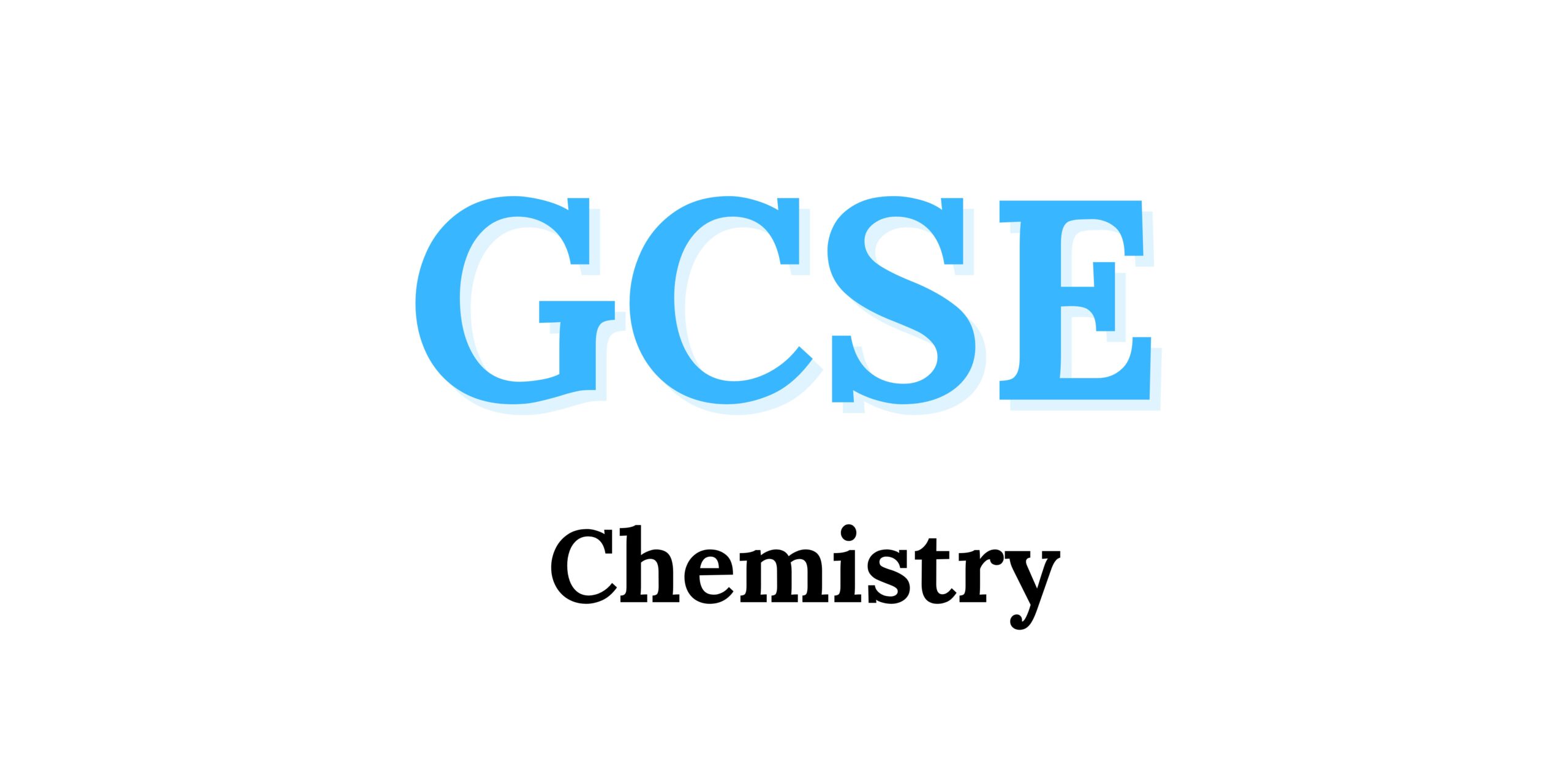
Overview of AQA GCSE Chemistry qualifications
Subject content:
1. Atomic structure and the periodic table
| Scope of study | Sections |
|---|---|
| A simple model of th atom, symbols, relative atomic mass, electronic charge and isotopes | • Atoms, elements and compounds • Mixtures • The development of the model of the atom (common content with physics) • Relative electrical charges of subatomic particles • Size and mass of atoms • Relative atomic mass • Electronic structure |
| The periodic table | • Elements in the periodic table • Development of the periodic table • Metals and non-metals • Elements of Group 0 • Elements of Group 1 • Elements of Group 7 |
| Properties of transition metals | • Comparison with Group 1 elements • Typical properties |
2. Bonding, structure, and the properties of matter
| Scope of study | Sections |
|---|---|
| Chemical bonds, ionic, covalent and metallic | • Chemical bonds • Ionic bonding • Ionic compounds • Covalent bonding • Metallic bonding |
| How bonding and structure are related to the properties of substances | • The three states of matter • State symbols • Properties of ionic compounds • Properties of small molecules • Polymers • Giant covalent structures • Properties of metals and alloys • Metals as conductors |
| Structure and bonding of carbon | • Diamond • Graphite • Graphene and fullerenes |
| Bulk and surface properties of matter including nanoparticles | • Sizes of particles and their properties • Uses of nanoparticles |
3. Quantitative chemistry
| Scope of study | Sections |
|---|---|
| Chemical measurements, conservation of mass and the quantitative interpretation of chemical equations | • Conservation of mass and balanced chemical equations • Relative formula mass • Mass changes when a reactant or product is a gas • Chemical measurements |
| Use of amount of substance in relation to masses of pure substances | • Moles • Amounts of substances in equations • Using moles to balance equations • Limiting reactants • Concentration of solutions |
| Yield and atom economy of chemical reactions | • Percentage yield • Atom economy • Using concentrations of solutions in mol/dm^3 • Use of amount of substance in relation to volumes of gases |
4. Chemical changes
| Scope of study | Sections |
|---|---|
| Reactivity of metals | • Metal oxides • The reactivity series • Extraction of metals and reduction • Oxidation and reduction in terms of electrons |
| Reactions of acids | • Reactions of acids with metals • Neutralisation of acids and salt production • Soluble salts • The pH scale and neutralisation • Titrations • Strong and weak acids |
| Electrolysis | • The process of electrolysis • Electrolysis of molten ionic compounds • Using electrolysis to extract metals • Electrolysis of aqueous solutions • Representation of reactions at electrodes as half equations |
5. Energy changes
| Scope of study | Sections |
|---|---|
| Exothermic and endothermic reactions | • Energy transfer during exothermic and endothermic reactions • Reaction profiles • The energy change of reactions |
| Chemical cells and fuel cells | • Cells and batteries • Fuel cells |
6. The rate and extent of chemical change
| Scope of study | Sections |
|---|---|
| Rate of reaction | • Calculating rates of reactions • Factors which affect the rates of chemical reactions • Collision theory and activation energy • Catalysts |
| Reversible reactions and dynamic equilibrium | • Reversible reactions • Energy changes and reversible reactions • Equilibrium • The effect of changing conditions on equilibrium • The effect of changing concentration • The effect of temperature changes on equilibrium • The effect of pressure changes on equilibrium |
7. Organic chemistry
| Scope of study | Sections |
|---|---|
| Carbon compounds as fuels and feedstock | • Crude oil, hydrocarbons and alkanes • Fractional distillation and petrochemicals • Properties of hydrocarbons • Cracking and alkenes |
| Reactions of alkenes and alcohols | • Structure and formulae of alkenes • Reactions of alkenes • Alcohols • Carboxylic acids |
| Synthetic and naturally occurring polymers | • Addition polymerisation • Condensation polymerisation • Amino acids • DNA (deoxyribonucleic acid) and other naturally occurring polymers |
8. Chemical analysis
| Scope of study | Sections |
|---|---|
| Purity, formulations and chromatography | • Pure substances • Formulations • Chromatography |
| Identification of common gases | • Test for hydrogen • Test for oxygen • Test for carbon dioxide • Test for chlorine |
| Identification of ions by chemical and spectroscopic means | • Flame tests • Metal hydroxides • Carbonates • Halides • Sulfates • Instrumental methods • Flame emission spectroscopy |
9. Chemistry of the atmosphere
| Scope of study | Sections |
|---|---|
| The composition and evolution of the Earth’s atmosphere | • The proportions of different gases in the atmosphere • The Earth’s early atmosphere • How oxygen increased • How carbon dioxide decreased |
| Carbon dioxide and methane as greenhouse gases | • Greenhouse gases • Human activities which contribute to an increase in greenhouse gases in the atmosphere • Global climate change • The carbon footprint and its reduction |
| Common atmospheric pollutants and their sources | • Atmospheric pollutants from fuels • Properties and effects of atmospheric pollutants |
10. Using resources
| Scope of study | Sections |
|---|---|
| Using the Earth’s resources and obtaining potable water | • Using the Earth’s resources and sustainable development • Potable water • Waste water treatment • Alternative methods of extracting metals |
| Life cycle assessment and recycling | • Life cycle assessment • Ways of reducing the use of resources |
| Using materials | • Corrosion and its prevention • Alloys as useful materials • Ceramics, polymers and composites |
| The Haber process and the use of NPK fertilisers | • The Haber process • Production and uses of NPK fertilisers |
For detailed information about the General Certificate of Secondary Education (GCSE) and how it can shape your academic future, click here to explore: GCSE Information
Required practical activities
1. Prepare a pure, dry sample of a soluble salt from an insoluble oxide or carbonate. Use a Bunsen burner to heat dilute acid and a water bath or electric heater to evaporate the solution.
2. Determine reaction volumes of strong acid and strong alkali solutions by titration.
Determining the concentration of one of the solutions in mol/dm^3 and g/dm^3 using the reaction volumes and the known concentration of the other solution.
3. Investigate the electrolysis of aqueous solutions using inert electrodes, developing a hypothesis.
4. Investigate variables affecting temperature changes in reacting solutions, such as acid plus metals, acid plus carbonates, neutralizations, and metal displacement.
5. Investigate how concentration changes affect reaction rates by measuring gas volume produced and observing color or turbidity changes, developing a hypothesis.
6. Use paper chromatography to separate and identify colored substances, calculating Rf values.
7. Use chemical tests to identify ions in unknown single-ion compounds, covering ions from the “Flame Tests” and “Sulfates” sections.
8. Analyze and purify water samples from a variety of sources, including pH, dissolved solids, and distillation.
Assessment
Assessment Objectives:
AO1: Demonstrate knowledge and understanding of scientific ideas, techniques, and procedures.
AO2: Apply knowledge and understanding of scientific ideas, inquiry, techniques, and procedures.
AO3: Analyze information and ideas to interpret and evaluate, make judgments and draw conclusions, and develop and improve experimental procedures.
| Type of assessment | Content | Final score | Weighting of final grade |
|---|---|---|---|
| Paper 1: Multiple choice, structured, closed short answer and open response | Topics 1–5: Atomic structure and the periodic table; Bonding, structure, and the properties of matter; Quantitative chemistry; Chemical changes; Energy changes. | 100 marks | 50% |
| Paper 2: Multiple choice, structured, closed short answer and open response | Topics 6–10: The rate and extent of chemical change; Organic chemistry; Chemical analysis; Chemistry of the atmosphere; Using resources. | 100 marks | 50% |
Assessment objective weightings for GCSE Chemistry
| Assessment objectives (AOs)* | Component weightings Paper 1 (%) | Component weightings Paper 2 (%) | Overall weighting (approx %) |
|---|---|---|---|
| AO1 | 37‒43 | 37‒43 | 40 |
| AO2 | 37‒43 | 37‒43 | 40 |
| AO3 | 17‒23 | 17‒23 | 20 |
| Overall weighting of components | 50 | 50 | 100 |
Assessment weightings
The marks on the papers will be scaled according to the weighting of each component. Students’ final marks will be the sum of these scaled marks. Grade boundaries will be determined based on this total scaled mark. The scaling and total scaled marks are detailed in the table below.
| Component | Maximum raw mark | Scaling factor | Maximum scaled mark |
|---|---|---|---|
| Paper 1 | 100 | x1 | 100 |
| Paper 2 | 100 | x1 | 100 |
| Total scaled mark: | 200 |
If you need help with Chemistry or any other subject, our tutors are ready to support you on your academic journey. Don’t miss your chance to succeed—take a trial lesson today!











